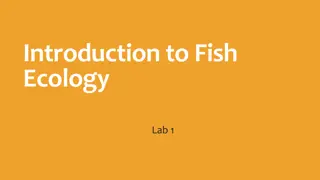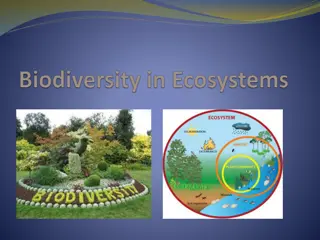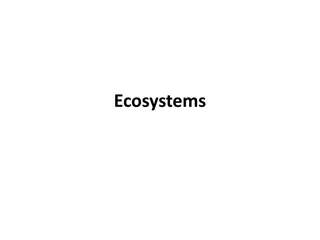Understanding Ecosystems: A Comprehensive Guide
An ecosystem comprises both living (biotic) and non-living (abiotic) factors interacting in a specific area, with populations, communities, and ecology playing essential roles. Abiotic factors like temperature, water, sunlight, and wind influence species distribution, while biomes categorize ecosystems by the plants they support. Explore the intricate web of life within ecosystems through this informative guide.
Download Presentation

Please find below an Image/Link to download the presentation.
The content on the website is provided AS IS for your information and personal use only. It may not be sold, licensed, or shared on other websites without obtaining consent from the author. Download presentation by click this link. If you encounter any issues during the download, it is possible that the publisher has removed the file from their server.
E N D
Presentation Transcript
What is a Ecosystem? An ecosystem is formed by the interactions between all living (biotic factors) and non-living things (Abiotic factors) in an area. An ecosystem may include many communities with different populations.
What is a Population? A population is one species living in a specific area. For example, all foxes living in an area form a population. Another example, all dandelions growing in an area form another population.
What is a Community? A community is formed from all living populations found in an area. All the foxes, dandelions, grasshoppers, snakes, hawks, deer, and skunks living in one area each form their individual populations, but together make up a community.
What is Ecology? Ecology is the study of how organisms interact with one another and with their environment.
Non-living parts of your community (Abiotic) Buildings Roads Bodies of water Land Wind Sunlight
Abiotic factors affect distribution of species Abiotic factors of interest include: - Temperature (range from 0 to 45 C) - Water - Sunlight - Wind (increases heat & water loss) -Rocks and soil -Amount of oxygen in the water Amount of oxygen in the water
Biome Is a collection of ecosystems that are similar or related to one another. Usually in the type of plants they support. The following are Canadian Biomes: Tundra Biome Boreal Forest Biome Temperate Deciduous Forest Biome Grassland Biome
Aquatic and terrestrial biomes (Biome = major ecosystem type)
A. Aquatic biomes cover about 75% of the earths surface - Wetlands - Lakes - Rivers, streams - Oceanic pelagic biome - Coral reefs
B. Terrestrial biomes - Tropical forest - Savanna - Desert - Chaparral - Temperate grassland - Temperate deciduous forest - Coniferous forest - Tundra
Tropical Forest: Vertical stratification with trees in canopy blocking light to bottom strata. Many trees covered by epiphytes (plants that grow on other plants).
Desert: Sparse rainfall (< 30 cm per year), plants and animals adapted for water storage and conservation. Can be either very, very hot, or very cold (e.g. Antarctica)
Temperate Grassland: Marked by seasonal drought and fires, and grazing by large animals. Rich habitat for agriculture.
Temperate Deciduous Forest: Mid-latitudes with moderate amounts of moisture, distinct vertical strata: trees, under story shrubs, herbaceous sub-stratum. Loss of leaves in cold, many animals hibernate or migrate then. Original forests lost from North America by logging and clearing.
Coniferous forest: Largest terrestrial biome on earth, old growth forests rapidly disappearing, usually receives lots of moisture as rain or snow.
Tundra: Permafrost (Permanent frozen ground), bitter cold, high winds and thus no trees. Has 20% of land surface on earth.























